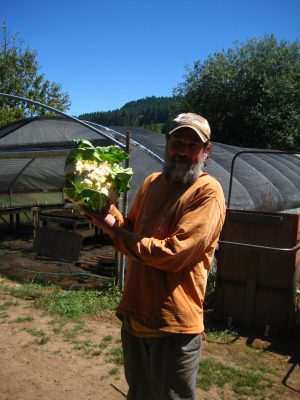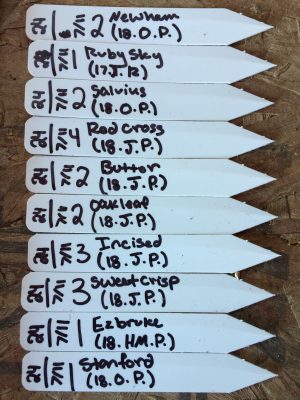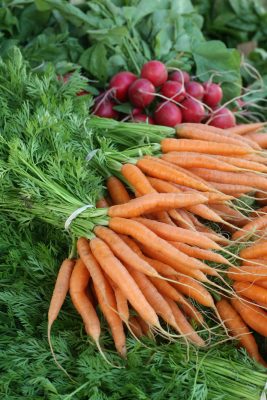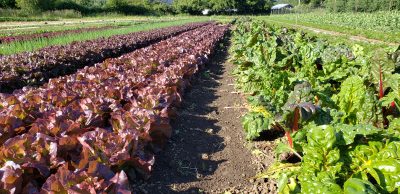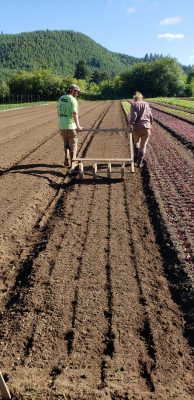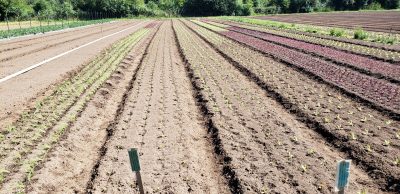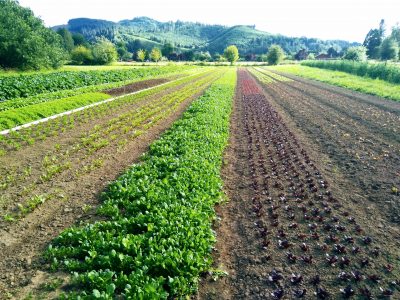
by Reiden Gustafson
“What’s causing all those tiny holes in the arugula?”
As an apprentice working the Horton Road market stands, I’ve heard this question asked several times. In an attempt to provide our customers with a more thorough answer, I put together a short Q&A regarding arugula and one of its biggest admirers.
Question: What’s causing all those tiny holes in the arugula? Answer: A black jumping beetle measuring only 1/15 of an inch. It’s commonly known as flea beetle. Flea beetles are avid leaf eaters. They have strong hind legs which help them jump. They also have the ability to fly. Both modes of transportation aid in seeking out meals by way of smell and sight. Here in Oregon flea beetles typically have three generations per growing season, with the first round of adults arriving in early-mid summer.
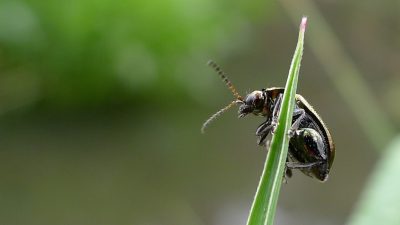
Question: What crops do flea beetles feed on? Answer: There are three main flea beetles found in the Pacific Northwest. The crucifer flea beetle (Phyllotreta cruciferae) feeds on brassica crops such as arugula, kale, broccoli, cauliflower, radish, turnip, tatsoi, etc. Other types of flea beetles feed on potatoes, tomatoes, and other plants in the solanaceae family.
Question: What are some control options available for organic farms and gardens? Answer: (see below)
- Row cover: Floating row cover products can be used to keep flea beetles off crops. Row covers can work well in certain conditions, however, they should are only effective at keeping insects out if they’re kept closed at all times. This can be a problem during hot sunny weather.
- Organic insecticide: Most organic insecticide sprays only work when they make physical contact with the insect. Flea beetles are quick to jump away when people approach them, making spraying difficult. Many insecticides (even organic ones) are also harmful to beneficial insects, so this is an important consideration.
- Trap crops: Some crops such as mustards and bok choy are especially tasty to flea beetles and can be used to lure pests away from the main crop. Trap crops can be planted in rows next to the main crop or as a bordering edge around the entire garden or field.
- Companion planting: Dill, green onion, and marigold are all examples of crops that can be interplanted near the main crop to help confuse and/or repel flea beetles.
- Sticky traps: As mentioned on a recent Farmer to Farmer podcast with Chris Blanchard and guest Olivia Huber, large sticky traps can be made using tangle feet (orchard glue paste) and a sheet of paper as wide as the farm/garden beds. The paper is simply carries over the beds, sticky side down. Given the beetle’s natural tendency to jump away from anything approaching, a large percentage will end up jumping into the trap.
Question: What does Horton Road do to control flea beetle? Answer: Horton chooses to focuses on maintaining a high level of soil health and the best field germination possible. Flea beetles tend to be less prevalent in high density plantings compared sparse or stressed stands.
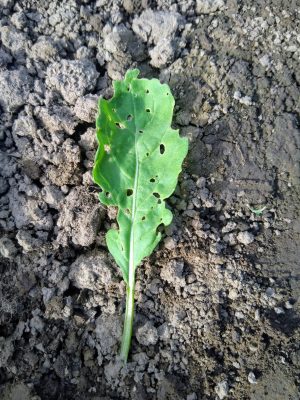
Question: Is it bad to eat holy arugula or other greens? Answer: No. The damage is cosmetic and doesn’t generally have an effect on flavor. Occasionally Horton may decide to forgo selling arugula at market one week because the available planting has too much insect damage… But don’t worry, the farm always has more planted and ready for harvest again soon.
Cheers to my fellow arugula lovers out there, and thanks for supporting organic agriculture!
Reiden is a first year apprentice at Horton. Having been born on the Oregon coast and then spending most of her life living elsewhere, Reiden is happy to once again be back in the familiar and beautiful coastal range.
Sources:
Farmer to Farmer podcast: http://www.farmertofarmerpodcast.com/
Parker, Joyce, et al., Organic Management of Flea Beetles. Pacific Northwest Extension, 2012, cru.cahe.wsu.edu/CEPublications/PNW640/PNW640.pdf.

